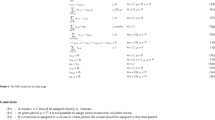Abstract
The International Timetabling Competition 2019 (ITC 2019) posed a university timetabling problem involving assigning classes to times and rooms for an entire semester while assigning students to required classes. We propose a new mixed integer programming (MIP) formulation of the problem. The MIP formulation takes advantage of different graph structures in conflict graphs to construct a strong formulation of the constraints. In addition, we introduce a reduction algorithm that removes redundancies from the input data. We show that the reduction algorithm, combined with the graph-based MIP formulation, outperforms the MIP formulated by Holm et al. (A MIP formulation of the International Timetabling Competition 2019 problem, 2020) and thus becomes the new state-of-the-art MIP formulation for the ITC 2019. This paper reports the graph-based MIP formulation, which we used during the ITC 2019, and discusses additional approaches that one can use to strengthen the MIP.





Similar content being viewed by others
References
Bagger, N., Desaulniers, G., & Desrosiers, J. (2019). Daily course pattern formulation and valid inequalities for the curriculum-based course timetabling problem. Journal of Scheduling, 22(2), 155–172. https://doi.org/10.1007/s10951-018-0582-0.
Bagger, N., Kristiansen, S., Sørensen, M., & Stidsen, T. (2019). Flow formulations for curriculum-based course timetabling. Annals of Operations Research, 280(1–2), 121–150. https://doi.org/10.1007/s10479-018-3096-4.
Bövarsdottir, E., Bagger, N., Høffner, L., and Stidsen, T. (2019). A comprehensive integer programming formulation of the nurse rostering problem in Denmark. Technical report. Technical University of Denmark.
Bron, C., & Kerbosch, J. (1973). Algorithm 457: Finding all cliques of an undirected graph. Communications of the ACM, 16(9), 575–577. https://doi.org/10.1145/362342.362367.
Burke, E. K., Mareček, J., Parkes, A. J., & Rudová, H. (2008). Penalising patterns in timetables: Novel integer programming formulations. In J. Kalcsics & S. Nickel (Eds.), Operations research proceedings 2007 (pp. 409–414). Berlin: Springer.
Burke, E. K., Mareček, J., Parkes, A. J., & Rudová, H. (2010). A supernodal formulation of vertex colouring with applications in course timetabling. Annals of Operations Research, 179(1), 105–130.
Burke, E. K., Mareček, J., Parkes, A. J., & Rudová, H. (2010). Decomposition, reformulation, and diving in university course timetabling. Computers and Operations Research, 37(3), 582–597. https://doi.org/10.1016/j.cor.2009.02.023.
Burke, E. K., Mareček, J., Parkes, A. J., & Rudová, H. (2012). A branch-and-cut procedure for the Udine Course Timetabling problem. Annals of Operations Research, 194(1), 71–87. https://doi.org/10.1007/s10479-010-0828-5.
Cooper, T. B., & Kingston, J. H. (1996). The complexity of timetable construction problems. In E. Burke & P. Ross (Eds.), Practice and theory of automated timetabling (pp. 281–295). Berlin: Springer.
Gramm, J., Guo, J., Hüffner, F., & Niedermeier, R. (2006). Data reduction, exact, and heuristic algorithms for clique cover. In In proceedings of the 8th ALENEX (pp. 86–94). SIAM.
Holm, D., Mikkelsen, R., Sørensen, M., & Stidsen, T. (2020). A MIP formulation of the international timetabling competition 2019 problem. Technical report. Technical University of Denmark.
Kou, L. T., Stockmeyer, L. J., & Wong, C. K. (1978). Covering edges by cliques with regard to keyword conflicts and intersection graphs. Communications of the ACM, 21(2), 135–139.
McCollum, B., Schaerf, A., Paechter, B., McMullan, P., Lewis, R., Parkes, A. J., et al. (2010). Setting the research agenda in automated timetabling: The second international timetabling competition. INFORMS Journal on Computing, 22(1), 120–130. https://doi.org/10.1287/ijoc.1090.0320.
Müller, T., Rudová, H., & Müllerová, Z. (2018). University course timetabling and International timetabling competition 2019. In Burke, E. K., Di Gaspero, L., McCollum, B., Musliu, N., & Özcan, E., (Eds.), Proceedings of the 12th international conference of the practice and theory of automated timetabling (PATAT 2018), Vienna, Austria (pp. 5–31).
Nemhauser, G. & Wolsey, L. (2014). Strong valid inequalities and facets for structured integer programs, In Integer and combinatorial optimization, chapter II.2 (pp. 259–295). Wiley. https://doi.org/10.1002/9781118627372.ch9.
Paechter, B., Gambardella, L., & Rossi-Doria, O. (2002). International timetabling competition 2002. http://sferics.idsia.ch/Files/ttcomp2002/
Post, G., Di Gaspero, L., Kingston, J. H., McCollum, B., & Schaerf, A. (2016). The third international timetabling competition. Annals of Operations Research, 239(1), 69–75. https://doi.org/10.1007/s10479-013-1340-5.
Author information
Authors and Affiliations
Additional information
Publisher's Note
Springer Nature remains neutral with regard to jurisdictional claims in published maps and institutional affiliations.
The authors would like to thank Niels-Christian Fink Bagger for providing Python code for finding clique covers. Dennis S. Holm’s Ph.D. project is part of the Data Science for University Management project (dsumsoftware.com) funded by MaCom A/S and Innovation Fund Denmark (IFD). Rasmus Ø. Mikkelsen’s industrial Ph.D. project is funded by IFD. IFD has supported the work solely financially and has not participated in any research-related activities.
Appendix
Appendix
1.1 A Notations
1.2 B Reduced distribution constraints
Table 12 shows the number of reduced distribution constraints by each method.
1.3 C Reduced variables
Table 13 shows the number of vertices reduced by fixed vertices and cliques for each type of graph.
1.4 D Specified MIP size
This appendix presents the numbers of the specific constraints in the model. Table 14 gives the number of constraints generated by the conflict graphs.Table 15 shows the number of distribution constraints not modeled by the class–time conflict graph. Table 16 presents the number of variables and constraints used to model student sectioning and student conflicts.
Rights and permissions
About this article
Cite this article
Holm, D.S., Mikkelsen, R.Ø., Sørensen, M. et al. A graph-based MIP formulation of the International Timetabling Competition 2019. J Sched 25, 405–428 (2022). https://doi.org/10.1007/s10951-022-00724-y
Accepted:
Published:
Issue Date:
DOI: https://doi.org/10.1007/s10951-022-00724-y




